As the Italian Grand Prix unfolds at Mugello, brake technology has taken center stage, especially following Francesco Bagnaia’s recent shift in brake disc specifications at the Aragon circuit. The discourse surrounding the prospect of switching to larger discs, while promising enhanced performance, reveals a complex narrative filled with technical intricacies and trade-offs. It’s essential to delve deeper into the implications of this technology to fully appreciate its role in the competitive landscape of MotoGP racing.
The Braking Challenge: Lessons from Aragon
At Motorland Aragon, Bagnaia initially relied on his conventional 340mm high-mass brake disc, a choice informed by the track’s energy demands. However, this standard setup was soon augmented during the warm-up when he experimented with a larger 355mm disc. While this move captured attention, it is essential to recognize that increased disc size does not come with straightforward advantages. Indeed, the magnitude of braking performance improvement may very well be offset by several associated drawbacks, such as increased weight, particularly concerning bike handling and rider dynamics during the race.
The Unique Terrain of Mugello
Mugello presents an entirely different set of challenges for competitors. Unlike Aragon, where the energy exerted on the brakes is significant, Mugello is characterized by a lighter braking load, raising questions about the efficacy of transitioning to a larger disc here. According to Brembo’s Andrea Pellegrini, Bagnaia will return to the 340mm disc for this high-speed track. The pressing consideration involves the implications of weight on the motorcycle’s overall performance. If the team opts for a larger disc, they must also account for supplementary equipment to facilitate rapid temperature regulation—adding yet another layer of complexity.
The Critical Role of Temperature Management
One of the key facets of modern MotoGP bikes is maintaining appropriate brake temperatures. As Pellegrini emphasized, inadequate heat leads to diminished stopping power. This vulnerability highlights that switching to a larger disc system requires altering not only the physical components but also the entire strategy behind thermal management. The necessity to employ extra covers to help heat the brake discs translates to added weight, which can adversely affect speed and agility on the track.
Performance Parameters: The Balancing Act
In this high-octane atmosphere, understanding the key performance indicators becomes paramount. Riders and teams must navigate this balancing act between weight, temperature, and the subsequent effect on bike handling. Large discs may provide certain advantages, but they need meticulous handling and strategic foresight to realize their full potential.
Ultimately, the discussions at Mugello underscore a critical lesson in racing engineering: innovation in technology must be approached with an understanding of the environment and conditions. As teams seek to optimize performance, the interplay between strategic component choices and track-specific demands will define success in MotoGP for seasons to come.

